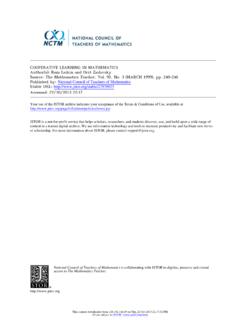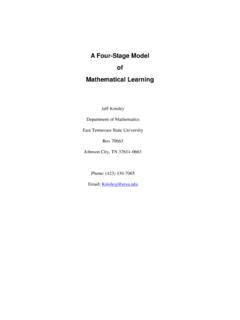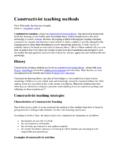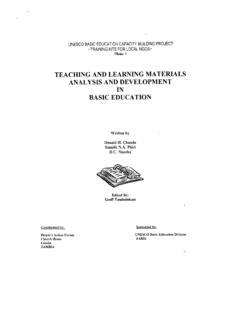Transcription of APPROACHES TO TEACHING AND LEARNING IN …
1 Alt + F=FuncEdit P=Plot S=Scale C=Clear O=Output M=Mode H=Help Q=Quit Font(X) - -x^2-5 Figure 2: Graphs of the form y = ax2+ c Alt + F=FuncEdit P=Plot S=Scale C=Clear O=Output M=Mode H=Help Q=Quit Font(X) --(x-5)A2+3 _ Figure 3 : Graphs of the form y=a(x-h)2 + d _ APPROACHES TO TEACHING AND LEARNING IN mathematics Peter Etches Editor's Note: This article is adapted from a foreword to a mathematics curriculum document written for the Cook Islands situation. It was felt, however, that many of the points would be of interest to and possibly applicable in other Pacific countries.
2 Modern educational research has shown conclusively that students are much more likely to learn and retain the LEARNING of a new concept or skill when they are able to make meaningful mental links with previously learned concepts or experiences. In the context of LEARNING mathematics this means that the teacher should: find out what the students have already learned in earlier years and use this as the basis for new LEARNING . provide a framework for the new LEARNING to occur.
3 The discovery of what students have already learnt is perhaps best achieved through the use of short Placement Tests, which can identify the skills and concepts that students already possess and hence determine the starting points for their TEACHING programme. The provision of a framework for new LEARNING to occur could be regarded as the major and most significant change from most current mathematics programmes. The mathematics that we want our students to learn should be introduced within a framework of familiar everyday experiences that are real and meaningful to the students, and to which they can readily relate the new skills and concepts.
4 It is to this end that each Achievement Objective commences with the phrase "Within a range of meaningful contexts, students should be able to: " Most of the suggested student activities, particularly those listed in the Supplementary Activities draw upon the sorts of experiences and environment that are already familiar to the student Many concern 14 the kinds of activity that the student may do or experience every day or from time to time. It is upon these experiences and activities that the mathematics , as stated in the Achievement Objectives, is built around.
5 Many of the activities integrate well with other subjects, craft work, Social Science, Science, Technology and Language etc. and hence students should come to appreciate that mathematics is not to be learnt in isolation as a separate subject, but that the skills and concepts learned can be applied and used immediately in their everyday living. Text Books Most mathematics text books that are in use today have very little in common with the approach to LEARNING as outlined above.
6 They have been written by foreign writers, and what may be expected to be an everyday experience of, for example, a 13-year-old student in New Zealand is very different for a 13-year-old Cook Islander living on Pukapuka. Most exercises in current text books use repetitive examples of the same kind to reinforce what is supposed to have been taught. However, modern research has indicated that repetition of examples that students are unable to link to previous experiences, does not in fact bring about real LEARNING .
7 Within the framework of this Syllabus document, text books are still, however, expected to play a part. Firstly, the teacher must create the LEARNING activity or environment which will enable students to make the necessary mental links with their previous experiences. Once this is achieved, the text book may then be used to supplement or reinforce those links. To this end, only those exercises or examples that strictly match the stated Achievement Objectives or which relate to the LEARNING activity are to be used.
8 Incorporated throughout the syllabus is the Mathematical Processes Strand. This strand should not be taught in isolation rather the stated Objectives of Problem-Solving, Developing Logic and Reasoning, and Communicating Mathematical Ideas will become an integral part of almost all mathematical activity that students are expected to tackle. Problem-Solving Students learn mathematical thinking most effectively through applying concepts and skills in interesting and realistic contexts which are personally meaningful to them.
9 Thus, mathematics is best taught by helping students to solve problems drawn from their own experience. Real-life problems are not always closed, nor do they necessarily have only one solution. The solutions to problems which are worth solving seldom involve only one item of mathematical understanding or only one skill. Rather than students remembering the single correct method, problem - solving requires them to search the information for clues and to make connections to the various pieces of mathematics and other knowledge, experiences and skills they have already learned.
10 Such problems encourage thinking rather than mere recall. Communicating Mathematical Ideas An increasing emphasis is placed on the development of students' ability to clearly communicate their thinking and reasoning. Merely obtaining the correct answer is now no longer sufficient. Students are now expected to obtain an answer, by whatever means, and then to explain, write about or demonstrate how they have obtained this answer.









